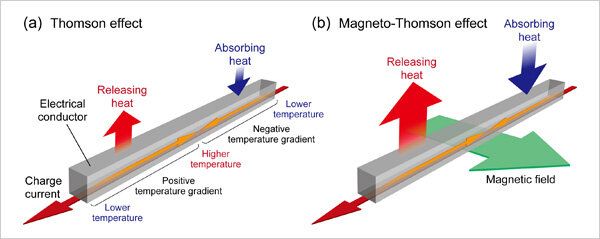Applying a temperature gradient and a charge current to an electrical conductor leads to the release and absorbtion of heat. This is called the Thomson effect. In a first, NIMS and AIST have directly observing the magneto-Thomson effect, which is the magnetic-field-induced modulation of the Thomson effect. This success may contribute to the development of new functions and technologies for thermal energy management and to advances in fundamental physics and materials science on magneto-thermoelectric conversion.
The Seebeck effect and the Peltier effect have been extensively investigated for their application to thermoelectric conversion technologies. Along with these effects, the Thomson effect has long been known as a fundamental thermoelectric effect in metals and semiconductors. Although the influence of magnetic fields and magnetism on the Seebeck and Peltier effects has been well understood as a result of many years of research, the influence on the Thomson effect has not been clarified because it is difficult to measure and evaluate.
This NIMS-led research team observed heat release and absorption induced in an electrical conductor by simultaneously creating a temperature gradient across it, passing a charge current through the gradient, and applying a magnetic field. The team precisely measured temperature changes in the conductor associated with the heat release and absorption using a heat detection technique called lock-in thermography. As a result, the amount of heat released and absorbed was found to be proportional to both the magnitude of the temperature gradient and charge current. In addition, the team observed strong enhancement of the resultant temperature change when a magnetic field was applied to the conductor. The systematic measurements performed in this study demonstrated that the heat release and absorption signals detected under a magnetic field were indeed generated by the magneto-Thomson effect.
